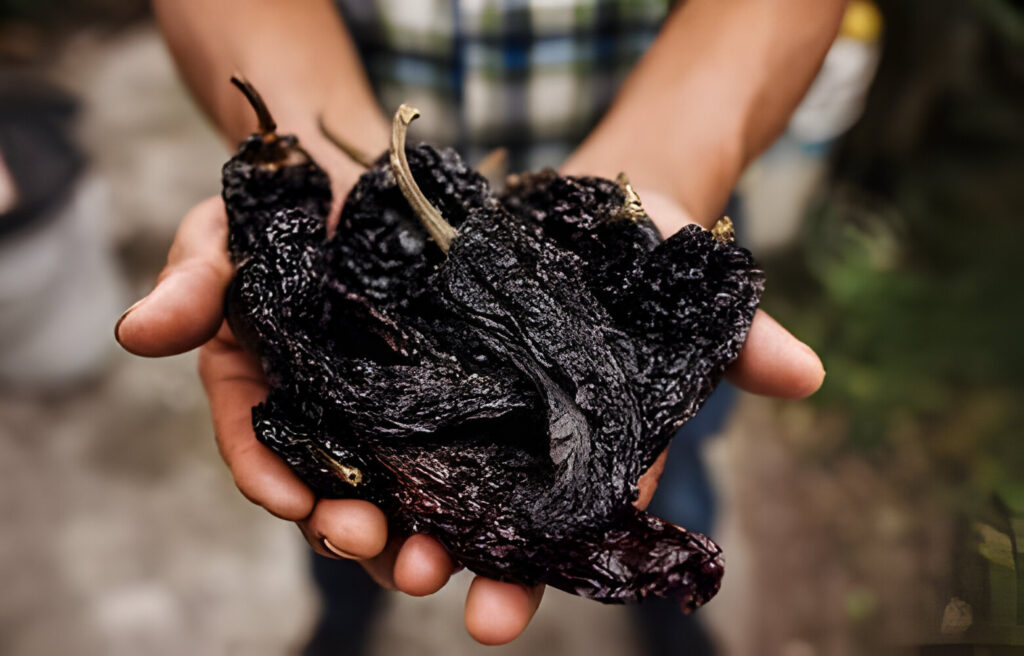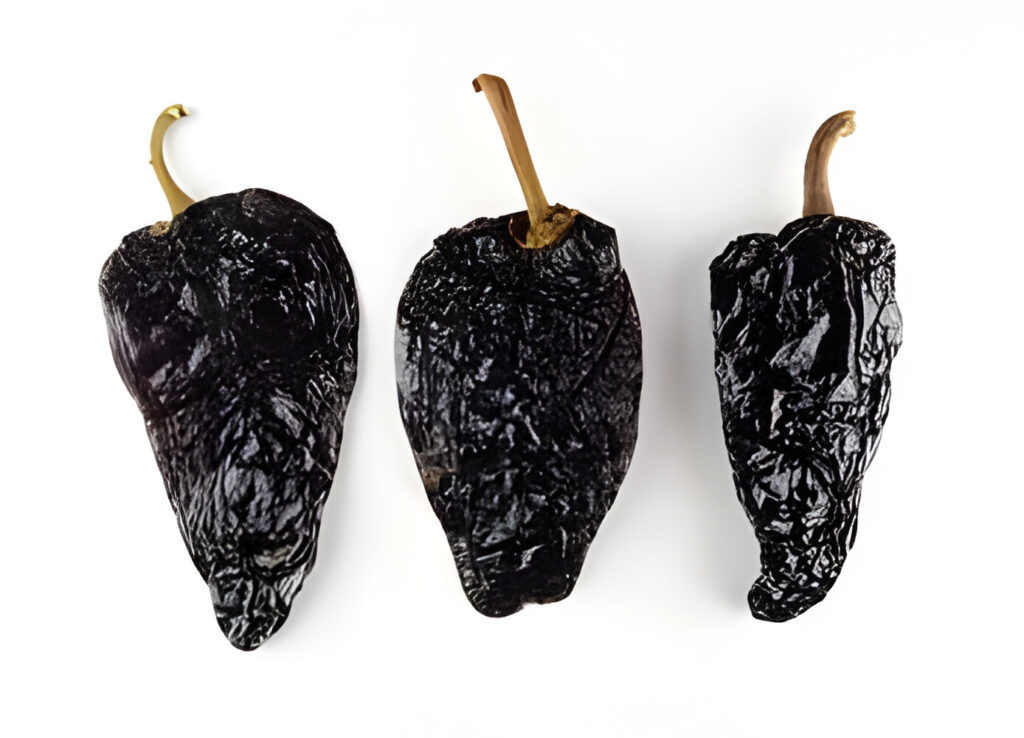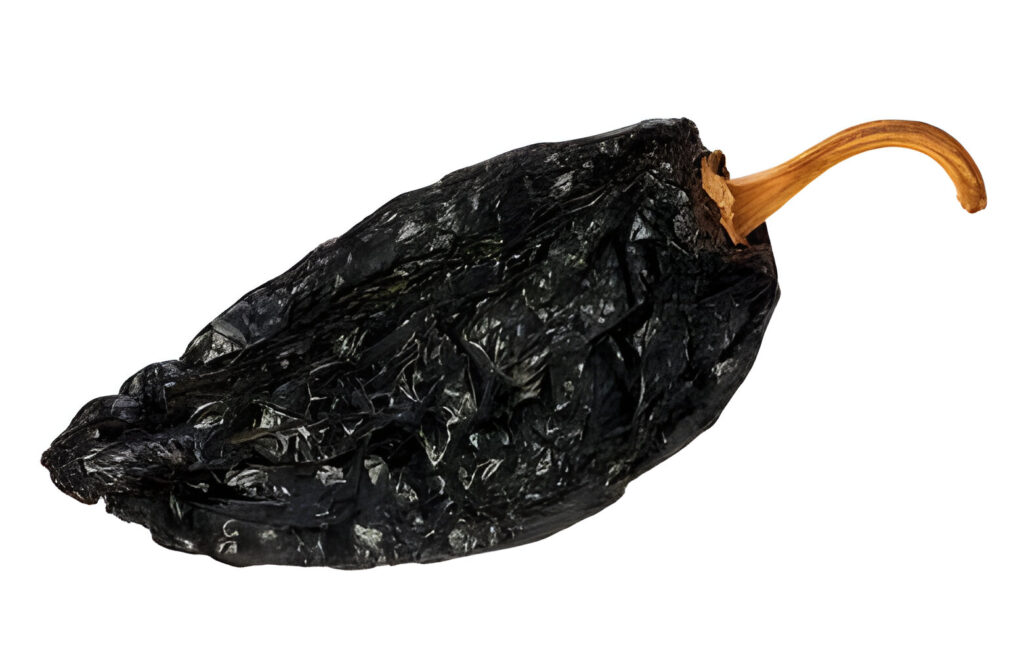
What is Ancho Chile?
Introduction to Ancho Chile
Ancho chile stands as a cornerstone of Mexican cuisine, renowned for its deep, smoky flavor and mild heat. Originating from the dried form of the poblano pepper, it plays a pivotal role in a myriad of dishes. This section unveils the essence of ancho , tracing its journey from fresh poblano to the culinary staple it becomes once dried.
The Transformation from Poblano to Ancho
The journey of ancho begins with the poblano pepper, a fresh, mild chili native to Mexico. Once it matures and turns a deep red, farmers handpick and dry these peppers under the sun. This process intensifies their flavor, morphing them into what we know as ancho chiles. These chiles feature a rich, raisin-like sweetness with a complexity that enhances countless recipes.
Distinct Characteristics of Ancho Chile
Ancho chiles distinguish themselves through their unique flavor profile. Noted for their mild heat, they offer nuances of chocolate, coffee, and a hint of earthiness. Their versatility shines in both traditional and contemporary dishes, making them indispensable in Mexican cuisine. Moreover, ancho chiles are broad and flat, characterized by a deep, reddish-brown hue and a pliable texture that signals quality.
Conclusion
Understanding ancho chile illuminates its pivotal role in culinary traditions. From its origins as a poblano pepper to its transformation into a dried spice, ancho enriches dishes with its distinctive flavor. As we delve deeper into its culinary uses, health benefits, and preparation techniques in the following sections, the versatility and importance of ancho continue to unfold.
The Culinary Uses of Ancho Chile
Versatility in the Kitchen
Ancho chile’s broad culinary application underscores its indispensability in Mexican cooking. Its unique flavor complements a diverse range of dishes, from hearty mains to subtle condiments. This section explores how ancho infuses depth and warmth into recipes, making it a favorite among chefs and home cooks alike.
Enhancing Sauces and Marinades
Ancho chile often serves as the backbone of rich, complex sauces and marinades. Its mild heat and smoky sweetness make it perfect for mole, a traditional Mexican sauce combining chocolate, spices, and ancho chiles. Similarly, ancho marinades transform meats and vegetables with their robust flavor, ensuring every bite is packed with depth.
Elevating Soups and Stews
The smoky notes of ancho bring a new dimension to soups and stews. Adding ground or rehydrated ancho chiles to these dishes introduces a subtle warmth and richness. It seamlessly melds with other ingredients, enhancing the overall flavor profile without overpowering it.
A Touch of Warmth in Desserts
Innovative chefs have begun incorporating ancho into desserts, revealing its versatility. A hint of ancho in chocolate-based desserts, such as brownies or truffles, introduces an intriguing complexity. This unexpected use showcases ancho chile’s ability to transcend traditional boundaries, adding a gentle heat that elevates the sweetness.
Conclusion
The culinary uses of ancho are as varied as they are vibrant. From its role in sauces and marinades to its surprising application in desserts, ancho proves to be a versatile and essential ingredient. As we continue to explore the benefits and preparations of this cherished spice, its contribution to Mexican cuisine and beyond remains clear.
Health Benefits of Ancho Chile
Nutritional Profile
Ancho chile, beyond its culinary appeal, is a powerhouse of nutrition. It contains vitamins A and C, essential for immune support and vision health. Furthermore, ancho offers a dose of minerals like potassium and iron, which are crucial for heart health and energy levels. This section dives into the myriad health benefits associated with ancho chile, highlighting its contribution to a balanced diet.
Anti-inflammatory Properties
One of the standout health benefits of ancho is its anti-inflammatory capabilities. The capsaicin present, although milder compared to other chilies, can help reduce inflammation in the body. This is particularly beneficial for managing conditions such as arthritis and heart disease. Regularly incorporating ancho into meals may thus play a role in a comprehensive anti-inflammatory diet.
Boosting Metabolism
The mild heat from ancho chile not only adds flavor but also stimulates metabolism. This can aid in weight management by increasing the rate at which the body burns calories. By incorporating ancho chile into a balanced diet, individuals may find it easier to maintain a healthy weight or potentially lose excess weight.
Antioxidant Effects
Ancho chile is rich in antioxidants, compounds that combat oxidative stress and reduce the risk of chronic diseases. These antioxidants can help protect cells from damage, supporting overall health and longevity. The inclusion of ancho in the diet is a simple way to boost antioxidant intake, contributing to disease prevention.
Conclusion
The health benefits of ancho extend far beyond its flavor. Its nutritional content, anti-inflammatory properties, metabolism-boosting effects, and antioxidant capacity make it a valuable addition to a health-conscious kitchen. As we explore how to select, store, and prepare ancho , its role in supporting wellness becomes increasingly clear.

Health Benefits
A Nutrient Powerhouse
Ancho chile is not just a flavor enhancer; it’s a nutritional treasure. Packed with essential vitamins, particularly vitamins A and C, it supports vision and immune function. Minerals like potassium and iron in ancho aid in maintaining heart health and boosting energy levels. This section underscores ancho chile’s role in a healthy diet, spotlighting its rich nutritional content.
Combatting Inflammation
Ancho chile’s anti-inflammatory properties are noteworthy. Although milder in capsaicin content compared to other peppers, it contributes to reducing bodily inflammation. This benefit is vital for managing conditions such as arthritis and reducing the risk of chronic diseases. Integrating ancho into daily meals could serve as a strategic move in an anti-inflammatory lifestyle.
Metabolic Boost for Weight Management
The mild heat of ancho chile does more than tantalize the taste buds; it also kicks the metabolism into higher gear. This metabolic boost is instrumental in weight management, aiding the body in burning calories more efficiently. For those focused on maintaining a healthy weight or shedding unnecessary pounds, ancho chile is a flavorful ally.
Antioxidant Richness
The antioxidants in ancho chile offer protection against oxidative stress and cellular damage, which are precursors to chronic diseases. By incorporating ancho chile into your diet, you’re not just adding depth to your dishes but also fortifying your body’s defense against disease. Its antioxidant properties underscore the importance of ancho chile in a health-conscious kitchen.
Conclusion
The myriad health benefits of ancho chile make it a standout ingredient in both culinary and health contexts. From its rich nutritional profile to its anti-inflammatory and metabolic benefits, chile is a versatile spice that supports overall well-being. As we delve into selecting, storing, and preparing chile, its contributions to health and cuisine continue to unfold.
How to Select and Store Ancho Chile
Choosing the Best Ancho Chiles
Selecting the highest quality ancho chiles is crucial for maximizing their flavor and health benefits. Look for chiles that are pliable and soft with a deep, reddish-brown color. They should feel leathery and supple, indicating they are not too old. Avoid any chiles that have signs of mold or are overly brittle, as these qualities can diminish their culinary value. A fresh, earthy scent is a good indicator of quality, suggesting the chiles will impart a robust flavor to your dishes.
Storing Ancho Chiles for Freshness
Proper storage extends the life of ancho chiles, retaining their essential flavors and nutrients. Keep them in a cool, dark place inside an airtight container. This method prevents moisture and air from spoiling the chiles. For longer storage, consider sealing them in vacuum bags and placing them in the refrigerator or freezer. This will preserve their quality for several months, ensuring you always have fresh ancho chile on hand for your cooking needs.
Signs of Quality and Freshness
Quality ancho chiles are key to creating flavorful and authentic dishes. When shopping, press gently on the chile to test its flexibility. Chiles that are too hard or crack indicate they are past their prime. The color should be vibrant without any gray or faded spots. Trusting these indicators will help you select the best ancho chiles, enhancing the taste and nutritional value of your meals.
Conclusion
Understanding how to select and store ancho chiles is essential for any cook looking to incorporate this versatile ingredient into their repertoire. By choosing high-quality chiles and following proper storage techniques, you can enjoy the full spectrum of flavors and benefits ancho chiles offer. As we move on to preparing and cooking with chile, keeping these tips in mind will ensure your dishes are both delicious and nutritious.
Preparing and Cooking
Rehydrating Ancho Chiles for Maximum Flavor
Rehydrating ancho chiles is a simple process that unlocks their full flavor potential. Start by removing the stems and seeds from the dried chiles. Then, soak them in hot water for about 15 to 20 minutes, until they become plump and tender. This method revives the chiles, making them perfect for blending into sauces, pastes, or marinades. Always ensure the water is hot but not boiling, as excessive heat can diminish the chiles’ nuanced flavors.
Incorporating Ancho Chile into Recipes
Ancho chile’s versatility makes it a staple in both traditional and modern cuisine. Once rehydrated, blend the chiles into a smooth paste that can serve as the base for various sauces and stews. Ground powder is also perfect for seasoning meats, vegetables, and even for adding a smoky depth to desserts. Its mild heat and rich flavor profile enhance dishes without overpowering other ingredients. Experiment with ancho chile in your cooking to discover its wide range of applications.
Pairing Ancho Chile with Other Ingredients
Ancho chile pairs wonderfully with ingredients that complement its smoky sweetness. Combine it with chocolate for a rich, complex flavor in desserts. In savory dishes, ancho chile works well with meats, especially pork and beef, offering a warm, earthy undertone. Its compatibility with other spices, like cumin and oregano, allows for creating vibrant, layered flavor profiles. Embrace the versatility of ancho chile to elevate your culinary creations.
Conclusion
Mastering the preparation and cooking with ancho chile opens up a world of flavor possibilities. From rehydrating the chiles to incorporating them into a variety of dishes, this spice is a gateway to exploring the depths of Mexican cuisine. As we move forward, understanding the cultural context will further enrich our appreciation for this indispensable ingredient.

Ancho Chile in Cultural Context
The Historical Roots
Ancho chile has deep historical roots in Mexican cuisine, tracing back to ancient civilizations like the Aztecs and Mayans. They valued it not only for its culinary uses but also for its medicinal properties. Today, continues to be a staple in Mexican cooking, symbolizing a bridge between the past and present. Its enduring presence highlights the importance of tradition in sustaining cultural identity.
Celebrations and Regional Dishes
Ancho chile plays a starring role in many Mexican celebrations and regional dishes. During Dia de los Muertos, it features in meals prepared to honor loved ones. In regional cuisine, ancho chile is the key ingredient in Poblano mole, a complex sauce that adorns various festive dishes. Its versatility and rich flavor make it a celebratory ingredient, enhancing the communal joy of Mexican festivities.
Modern Innovations with Ancho Chile
Contemporary chefs and food enthusiasts are finding new ways to showcase ancho chile. From innovative twists on traditional dishes to its incorporation into modern culinary creations, ancho chile is experiencing a renaissance. Restaurants across the globe are adopting it, introducing its unique flavor to an international audience. This trend not only celebrates Mexican cuisine but also demonstrates the global appeal of ancho chile.
Conclusion
Ancho chile’s significance extends beyond its culinary applications, representing a vital component of Mexican culture and heritage. From its historical roots to its role in celebrations and its embrace by modern cuisine, ancho chile exemplifies the dynamic nature of food traditions. As we explore and appreciate the multifaceted aspects of ancho chile, we pay homage to a spice that has captivated palates and cultures for centuries.
Frequently Asked Questions
What Is Ancho Chile?
Ancho chile is the dried form of the poblano pepper, known for its mild heat and smoky, sweet flavor. It is a staple in Mexican cuisine, used in sauces, stews, and marinades to add depth and complexity to dishes.
How Do You Store Ancho Chiles?
Store ancho chiles in a cool, dark place inside an airtight container to maintain their flavor and prevent spoilage. For longer preservation, you can keep them in the refrigerator or freezer, where they will last for several months.
Can Ancho Chile Be Eaten Raw?
Ancho chiles are typically used dried or rehydrated in cooking and are not commonly consumed raw. Rehydrating them in hot water softens the chiles and makes them suitable for blending into sauces or pastes.
Are Ancho Chiles Spicy?
Ancho chiles are considered mild in terms of heat. They provide a subtle warmth rather than a sharp spiciness, making them suitable for a wide range of palates and dishes.
How Do Ancho Chiles Benefit Health?
Ancho chiles are rich in vitamins A and C, antioxidants, and minerals like potassium and iron. They offer anti-inflammatory and metabolism-boosting properties, contributing to a healthy diet.
Can I Substitute Ancho Chile With Another Chile?
If you cannot find ancho chile, you can substitute it with mulato or guajillo chiles for a similar flavor profile. However, each type of chile will bring its unique taste and heat level to dishes.
How Can I Incorporate Ancho Chile into My Cooking?
Ancho chile can be rehydrated and blended into sauces, used as a seasoning in its ground form, or added to marinades. Its versatile flavor complements meats, vegetables, and even some desserts, like chocolate-based treats.
More from Maya’s recipes: